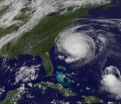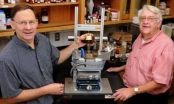(Press-News.org) UCSF researchers today unveiled a prototype model of the first implantable artificial kidney, in a development that one day could eliminate the need for dialysis.
The device, which would include thousands of microscopic filters as well as a bioreactor to mimic the metabolic and water-balancing roles of a real kidney, is being developed in a collaborative effort by engineers, biologists and physicians nationwide, led by Shuvo Roy, PhD, in the UCSF Department of Bioengineering and Therapeutic Sciences.
The treatment has been proven to work for the sickest patients using a room-sized external model developed by a team member in Michigan. Roy's goal is to apply silicon fabrication technology, along with specially engineered compartments for live kidney cells, to shrink that large-scale technology into a device the size of a coffee cup. The device would then be implanted in the body without the need for immune suppressant medications, allowing the patient to live a more normal life.
"This device is designed to deliver most of the health benefits of a kidney transplant, while addressing the limited number of kidney donors each year," said Roy, an associate professor in the UCSF School of Pharmacy who specializes in developing micro-electromechanical systems (MEMS) technology for biomedical applications. "This could dramatically reduce the burden of renal failure for millions of people worldwide, while also reducing one of the largest costs in U.S. healthcare."
The team has established the feasibility of an implantable model in animal models and plans to be ready for clinical trials in five to seven years.
End-stage renal disease, or chronic kidney failure, affects more than 500,000 people per year in the United States alone, and currently is only fully treated with a kidney transplant. That number has been rising between 5-7 percent per year, Roy said, in part because of the kidney damage associated with diabetes and hypertension.
Yet transplants are difficult to obtain: a mere 17,000 donated kidneys were available for transplant last year, while the number of patients on the transplant waiting list currently exceeds 85,000, according to the Organ Procurement ant Transplant Network.
Roughly 350,000 patients are reliant on kidney dialysis, Roy explained, which comes at a tremendous cost. The Medicare system alone spends $25 billion on treatments for kidney failure – more than 6 percent of the total budget – while the disease affects only 1 percent of Medicare recipients, he said. That cost includes almost $75,000 per patient each year for dialysis, according to the U.S. Renal Data System.
Dialysis also takes a human toll. A typical dialysis schedule is three sessions per week, for 3 to 5 hours per session, in which blood is pumped through an external circuit for filtration. This is exhausting for patients and only replaces 13 percent of kidney function, Roy said. As a result, only 35 percent of patients survive for more than 5 years.
With the limited supply of donors, that means thousands of patients die each year waiting for a kidney.
The implantable device aims to eradicate that problem. The two-stage system uses a hemofilter to remove toxins from the blood, while applying recent advances in tissue engineering to grow renal tubule cells to provide other biological functions of a healthy kidney. The process relies on the body's blood pressure to perform filtration without needing pumps or an electrical power supply.
The project exemplifies the many efforts under way at UCSF to build collaborations across scientific disciplines that accelerate the translation of academic research into real solutions for patients, according to Mary Anne Koda-Kimble, PharmD, dean of the UCSF School of Pharmacy.
"This is a perfect example of the work we are doing at UCSF to address some of the most critical medical issues of our time, both in human and financial costs," Koda-Kimble said. "This project shows what can be accomplished by teams of scientists with diverse expertise, collaborating to profoundly and more quickly improve the lives of patients worldwide."
The creation of the Department of Bioengineering and Therapeutic Sciences – a joint department in the UCSF schools of Pharmacy and Medicine – was itself an effort to promote translational research at UCSF by forming collaborations across biomedical specialties. Roy is also a founding faculty member of the UCSF Pediatric Device Consortium, which aims to accelerate the development of innovative devices for children health, and a faculty affiliate of the California Institute for Quantitative Biosciences (QB3) at UCSF.
His team is collaborating with 10 other teams of researchers on the project, including the Cleveland Clinic where Roy initially developed the idea, Case Western Reserve University, University of Michigan, Ohio State University, and Penn State University.
The first phase of the project, which has already been completed, focused on developing the technologies required to reduce the device to a size that could fit into the body and testing the individual components in animal models. In the second and current phase, the team is doing the sophisticated work needed to scale up the device for humans. The team now has the components and a visual model and is pursuing federal and private support to bring the project to clinical use.
###
UCSF is a leading university dedicated to promoting health worldwide through advanced biomedical research, graduate-level education in the life sciences and health professions, and excellence in patient care.
Follow UCSF on Twitter at http://twitter.com/ucsfnews
END
Hurricane Earl is still a powerful category four hurricane on the Saffir-Simpson Scale as it approaches the North Carolina coast today. NASA's Tropical Rainfall Measuring Mission (TRMM) satellite observed the high rates rain was falling within Earl, in some areas more than 2 inches per hour. Today, the Global Hawk unmanned aircraft is also flying into the eye of Hurricane Earl at altitudes of 60,000 feet to gather information about the storm.
Hurricane Earl became the most powerful hurricane of the 2010 Atlantic season early on September 2 when its sustained winds reached ...
ANN ARBOR, Mich.---Protecting helicopters in combat from heat-seeking missiles is the goal of new laser technology created at the University of Michigan and Omni Sciences, Inc., which is a U-M spin-off company.
"Battlefield terrain in places like Afghanistan and Iraq can be so rough that our troops have often had to rely on helicopters, and they can be easy targets for enemies with shoulder-launched missiles," said Mohammed Islam, a professor in the Department of Electrical Engineering and Computer Science.
"Our lasers give off a signal that's like throwing sand in ...
Bermuda has warnings up as Tropical Storm Fiona approaches, and GOES-13 satellite imagery from today shows that Fiona, although packing a punch, is a much smaller system that her brother, the Category 4 Hurricane Earl.
A tropical storm warning is in effect for Bermuda today, Sept. 2, as tropical storm force winds are expected there by late Friday. Bermuda can expect between 1 to 3 inches of rainfall from Fiona.
When the Geostationary Operational Environmental Satellite called GOES-13 captured a visible image of Tropical Storm Fiona approaching Bermuda this afternoon ...
BIRMINGHAM, Ala. – Cigarette smoke shuts off a key enzyme in airways that regulates the body's response to inflammation, according to findings from the University of Alabama at Birmingham published online today at Science Express.
The UAB researchers say smoke inhibits the enzyme, called Leukotriene A4 Hydrolase (LTA4H), causing it to fail in its job of shutting down white blood cells following a successful response to inflammation.
The team says the research study identified a previously unknown substrate of LTA4H called proline-glycine-proline (PGP). In a normal ...
COLUMBUS, Ohio – There is yet no straightforward way to determine the optimal dose level and treatment schedules for high-dose radiation therapies such as stereotactic radiation therapy, used to treat brain and lung cancer, or for high-dose brachytherapy for prostate and other cancers.
Radiation oncologists at the Ohio State University Comprehensive Cancer Center-Arthur G. James Cancer Hospital and Richard J. Solove Research Institute (OSUCCC-James) may have solved the problem by developing a new mathematical model that encompasses all dose levels.
Typically, radiation ...
BETHESDA, Md., Sept. 2, 2010 – The American Society for Biochemistry and Molecular Biology expressed its disapproval and disappointment this week in response to the Aug. 23 ruling in the U.S. District Court for the District of Columbia that granted a preliminary injunction barring federal funding of embryonic stem-cell research.
In a statement, the society said the decision, which came in response to a lawsuit filed by two adult stem-cell researchers, effectively halts human embryonic stem-cell research in the United States and "represents a crossroads in American scientific ...
COLLEGE PARK, Md. – A new report by terrorism researchers at the University of Maryland concludes that the deadly hostage-taking incident at the Discovery Communications headquarters in suburban Washington, D.C. meets the criteria of a terrorist act – a rare one for media organizations and the nation's capital region. Hostage-taking, though, is a familiar pattern in capital-region terror, the researchers add.
The report from the University of Maryland's START Center – the federally funded National Consortium for the Study of Terrorism and Responses to Terrorism – also ...
Tropical Depression Nine strengthened yesterday into Tropical Storm Gaston, but today it ran into dry and stable air and weakened back into a depression again.
When NASA's Aqua satellite flew over Gaston early this morning, Sept. 2 at 0423 UTC (12:23 a.m. EDT), the infrared image taken from the Atmospheric Infrared Sounder (AIRS) instrument showed that Tropical Depression Gaston seemed to have a compact circulation with some high, cold thunderstorm cloud tops around its center of circulation. Those clouds reached so high into the troposphere that they were colder than ...
AMES, Iowa – Iowa State University researchers have found a way to produce high-value chemicals such as ethylene glycol and propylene glycol from biomass rather than petroleum sources.
Walter Trahanovsky, an Iowa State professor of chemistry who likes to write out the chemical structures of compounds when he talks about his science, was looking to produce sugar derivatives from cellulose and other forms of biomass using high-temperature chemistry. And so he and members of his research group studied the reactions of cellulosic materials in alcohols at high temperatures ...
ANN ARBOR, Mich. — School children who consume foods purchased in vending machines are more likely to develop poor diet quality – and that may be associated with being overweight, obese or at risk for chronic health problems such as diabetes and coronary artery disease, according to research from the University of Michigan Medical School.
The study also looked at foods sold in school stores, snack bars and other related sales that compete with USDA lunch program offerings and found that these pose the same health and diet risks in school-aged children.
"The foods that ...



